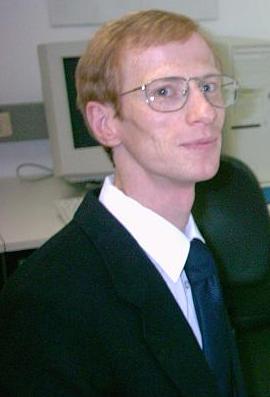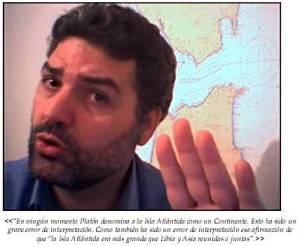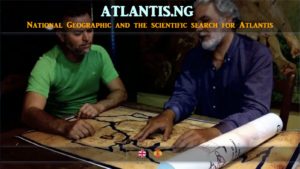Jacques Collina-Girard
Spartel Island *
Spartel Island also known as the Majuan Bank, was situated just west of the Strait of Gibraltar and according to Jacques Collina- Girard was the site of Atlantis. There is little doubt that before the last deglaciation, Spartel was dry land.
Girard was the site of Atlantis. There is little doubt that before the last deglaciation, Spartel was dry land.
Marc-Andre Gutscher from the University of Brest subsequently added some support to Collina-Girard’s theory based on his interpretation of new bathymetric data and was prepared to debate the viability of human habitation on Spartel around 9600 BC. According to Gutscher, a large earthquake hit the island 12,000 years ago. Furthermore, there is also evidence of at least eight subsequent earthquakes, each of which could have resulted in a drop of the seafloor by several metres.
Accordingly, Gustcher speculated that Spartel circa 9600 BC could have been 40 metres higher than expected. However, at this early date, he would not expect the Bronze Age civilisation described by Plato to have existed on the island but his sonar investigation did not reveal any suggestion of an extinct civilisation.
“He calculated that between 20,000 and 12,000 years ago Spartel shrank from 6.5 x 4 km to less than a km across. A high-resolution map he made with sonar indicated that the island was even smaller than Collina-Girard had speculated, meaning it would have been uninhabitable as long as 14,000 years ago. But the sediment gathered by Gutscher tells a different story. A magnitude 9 earthquake appears to have rocked the region around the believed time of Atlantis’ doom, Gutscher reports in the August 2005 issue of Geology. At that time, the island would have been big enough to be inhabited. He also found evidence of subsequent earthquakes and tsunamis–apparently every 2000 years–that may have whittled the rest of the island away.” (c)
Gutscher found no evidence to support an ancient culture. “I will admit I was hoping to find concentric structures or walls of some kind,” he says, “but we didn’t”
Gustcher later withdrew his support for a Spartel Atlantis(a). However, Collina-Girard continues to advocate the idea, expanding on his views in a 2009 book[0999], L’Atlantide retrouvée? Enquête scientifique autour d’un mythe.
Further criticism of Collina-Girard’s theory has been voiced by Alain Moreau(b).
(a) https://archaeology.about.com/od/controversies/a/atlantis05_3.htm
(b) https://www.mondenouveau.fr/continents-disparus-les-fausses-atlantides-antarctique-ile-du-cap-spartel-partie-4/ (link broken Oct. 2017)
(c) https://www.science.org/content/article/atlantis-rises-again (pay wall)*
Kühne, Dr. Rainer Walter *
 Dr Rainer Walter Kühne was born in Braunschweig, Germany in 1970 and has a Ph.D. in Physics (Dortmund 2001). He has proposed a modification of Quantum Electrodynamics (QED), which predicts a second kind of photon (’magnetic photon’) and a second kind of light (’magnetic photon rays’). He has also offered evidence for the existence of a rotating universe. He lectured in the Institute of Physics at Dortmund University.
Dr Rainer Walter Kühne was born in Braunschweig, Germany in 1970 and has a Ph.D. in Physics (Dortmund 2001). He has proposed a modification of Quantum Electrodynamics (QED), which predicts a second kind of photon (’magnetic photon’) and a second kind of light (’magnetic photon rays’). He has also offered evidence for the existence of a rotating universe. He lectured in the Institute of Physics at Dortmund University.
Kühne had studied Plato’s Atlantis story and concluded that many of its elements are fictional although based on three historical but unconnected sources. For example, on the basis of Plato’s description of the Acropolis at the time of the ‘Atlantean’ war, it can be dated to around 1200 BC, not 9600 BC. He linked the Atlantean war with the invasion of the ‘Sea Peoples’ recorded by the Egyptians and locates Atlantis in Andalusia in Southern Spain and places its capital in the valley of the Guadalquivir, south of Seville. Satellite photos of this same area have recently revealed rectangular structures surrounded by parts of concentric circles with dimensions similar to Plato’s description of Atlantis. Werner Wickboldt, a teacher, who lives in Braunschweig (Kühne’s birthplace) announced the discovery of these features on January 8th, 2003. These structures include a rectangle of size 180 meters x 90 meters (Temple of Poseidon?) and a square of length 180 meters (Temple of Poseidon and Cleito?). Concentric circles surround these two rectangular structures so that the site closely resembles Plato’s description of the Atlantean capital. However, the dimensions of this location are approximately 20% larger than Plato’s figures, so Kühne has suggested that the unit of measurement used by Plato, the stade, may have been greater than usually accepted(i).
Kühne also proposes that Tartessos can be identified as the biblical Tarshish and is the model for Plato’s Atlantis(d).
It was a surprise to many when, in their June 2004 edition[429], the highly respected journal Antiquity published details of this discovery and Kühne’s interpretation(a).
To add a bit of spice to Kühne’s investigations, he, together with Jacques Collina-Girard, has been accused of plagiarism by Georgeos Diaz-Montexano(b).
Overall, despite offering a number of interesting thoughts regarding Plato’s Atlantis, we find Kühne sceptical regarding its actual existence, describing Plato’s account of it as a “philosophical fiction invented to describe Plato’s fictitious ideal state in the case of war.” Nevertheless, he is keen to point out that the narrative does contain historically factual elements.(e)
The excellent German site, atlantisforschung.de has described Kühne in the following terms(g), “Dr Kühne is one of the most distinguished representatives of university-scientifically oriented Atlantis research in Germany. Among other things, he discusses the possibility that Plato in his Atlantis story mixed an account of the Sea Peoples and Athens around 1200 BC with traditions about a Spanish city, which could have been the Iberian metropolis of Tartessos – probably destroyed in the 6th century BC by a Carthaginian expeditionary corps.”
The site also includes a link to an interesting paper by Kühne in which he lists the main references to Atlantis in the scientific literature(h).
An outline of Kühne’s theories, in English, is also available on the Internet(c).
In issue #46 of Atlantis Rising magazine Kühne published a letter outlining his experiences when he sought to present his diploma thesis and later his Ph.D. thesis including material that ran counter to that of his professor. In his words “To conclude, what can happen when a young researcher thinks he has an important theory? From my own experience, I learned that he will get difficulties with the acceptance of his diploma thesis. It will become impossible to start a Ph.D. thesis at the same university. His professor will decline to accept his dissertation. After completion of his Ph.D. thesis, he will be unemployed, although by then he has ten scientific publications, eight of them authored by him alone.”(f)
(a) https://antiquity.ac.uk/ProjGall/kuhne/ (if offline, see Archive 2081)
(b) eListas.net – Mis eListas: odiseo: Mensajes (archive.org) *
(c) Location and Dating of Atlantis (archive.org)
(d) https://vixra.org/pdf/1104.0035v1.pdf
(e) Did Ulysses Travel to Atlantis – https://vixra.org/pdf/1103.0058v1.pdf
(f) Atlantis Rising magazine #46 p6 At – PDF Archive
(g) Rainer W. Kühne – Atlantisforschung.de (German)
(h) Atlantis in the Scientific Literature – Atlantisforschung.de (German)
Archive 7057 | (atlantipedia.ie) (English)
Gutscher, Marc-André
Marc-André Gustier is an American-born geophysicist at the University of Western Brittany. He addressed the 2005 Atlantis Conference on the subject of Spartel Island, now submerged just beyond the Strait of Gibraltar , but above sea level during the last Ice Age. Prof. Jacques Collina-Girard had proposed Spartel as a possible location for Atlantis four years earlier. Gutscher subsequently(a) withdrew his support for a Spartel Atlantis.
, but above sea level during the last Ice Age. Prof. Jacques Collina-Girard had proposed Spartel as a possible location for Atlantis four years earlier. Gutscher subsequently(a) withdrew his support for a Spartel Atlantis.
Gutscher’s theory was attacked on the grounds that no advanced civilisation existed 12,000 years ago. Although Gutscher retracted his earlier position, Collina-Girard has stubbornly continued to espouse his views, expanding his argument in a 2009 book[0752].
(a) https://archaeology.about.com/od/controversies/a/atlantis05_3.htm
Diaz-Montexano, Georgeos
Georgeos Diaz–Montexano (1966- ) is the nom de plume of Cuban-born Jorge Diaz Sanchez. He has been exploring off the coast of southern Spain and Gibraltar for evidence of Atlantis. He is the founder of the Civilisations Origins Scientific Society and is a  leading advocate for the Afro-Iberian location theory. He contends that Atlantis was only partially submerged and that parts of it, which remained above water, are now to be found in southwest Spain and northern Morocco.
leading advocate for the Afro-Iberian location theory. He contends that Atlantis was only partially submerged and that parts of it, which remained above water, are now to be found in southwest Spain and northern Morocco.
Jacques Collina-Girard who, the following year also opted for the Strait of Gibraltar and more specifically Spartel Island mirrored Montexano’s theory on the location of Atlantis, first expressed publicly in April 2000. Intense rivalry exists between the two men as is evident from the content of Diaz-Montexano’s websites.
More recently Diaz-Montexano has also accused Dr. Rainer W. Kühne of plagiarism(a) and for good measure threw in a few unkind words about Robert Sarmast and his identification of Cyprus as the location of Atlantis. His online debates in various forums with other writers have been frequently marred by acrimony.
Diaz-Montexano has studied the earliest versions of the Atlantis story and published a considerable amount of controversial material on the Internet relating to the accuracy of the Platonic texts that we use today. Unfortunately, the English version of this work has been poorly translated from Spanish leaving a monolingual such as myself unable to clearly understand what has been written. One of the most interesting comments(b) from Diaz-Montexano relates to his study of a 16th-century translation of Critias that in his view indicates that 9,000 was NOT the number of years recorded by Solon. His firm conclusion is that Atlantis was destroyed between 1500BC and 1300BC.
Diaz-Montexano has also unearthed a number of ancient Spanish works including a Chronicle of Zaragoza that he maintains includes a number of obvious references to a Spanish connection with Atlantis(c). Unfortunately, once again, the quality of his English makes any clear reading very difficult. The only ‘Chronicle of Zaragoza’ that I could locate was a two-page document covering the period 450–568 AD that is totally unrelated to the Atlantis question. Nevertheless, it does appear that he has discovered information that may have an important bearing on the resolution of the Atlantis mystery.
Without wishing to detract from any work that Diaz-Montexano has done, it may be no harm to point out that while he has been free with his accusations of plagiarism, he himself has been accused of fraudulently misleading the public regarding his academic qualifications(d).
In August 2012 he published the first volume of a large six-volume work, ATLANTIS <> TARTESSOS. AEGYPTIUS CODEX. Epítome de la Atlántida Histórico-Científica, devoted to arguing the case for a Iberian Atlantis. Unfortunately, this huge undertaking is only available, at least initially, in Castilian Spanish. This promises to be an important addition to Atlantean literature and Diaz-Montexano is to be congratulated for his efforts.
The first volume begins with a critical overview of recent Atlantis theories such as those of Robert Sarmast (Cyprus) and Ulf Erlingsson (Ireland) and then proceeds to analyse the texts of ancient writers wherever they refer directly or indirectly to Atlantis. He cites the original Greek texts together with a modern (Spanish) translation. This first volume is also available as an inexpensive (€1.95) Kindle ebook. July 2015 saw the publication of another Kindle book by Diaz-Montexano entitled ATLÁNTIDA Historia y Ciencia (Atlantis: History and Science)[1105] together with a synopsis online(e).
Late in 2016 will see the broadcasting of a new documentary by National Geographic concerning Atlantis in the Mediterranean. Diaz-Montexano has already been interviewed in connection with this production as has Robert Ishoy. The exact focus of the show, if there is one, is still unclear, but the involvement of James Cameron and Simcha Jacobovici as co-producers has been widely publicised.
In conjunction with the filming of the new NG documentary, Diaz-Montexano has decided to publish, in English, the details of his Atlantis studies over the past decades. Available is the introduction and outline of the new book(f), NG National Geographic and the scientific search for Atlantis[1394] published in January 2017, in both English and Spanish, to coincide with the airing of the documentary at the end of that month.
 (a) eListas.net – Mis eListas: odiseo: Mensajes (archive.org) *
(a) eListas.net – Mis eListas: odiseo: Mensajes (archive.org) *
(d) https://www.samizdata.net/mt/93uhdy736.cgi?entry_id=4856
(e) See: Archive 2579 (English & Spanish)
(f) https://web.archive.org/web/20190517172152/https://atlantisng.com/en/
Dendl, Jörg (t)
Jörg Dendl was born in 1964 and studied ancient history at the Friedrich Meinecke Institut. Dendl  now works as a publisher, lecturer and writer, embracing a wide range of historical subjects. Among these is Plato’s Atlantis, which he is convinced lay in the Atlantic. He would appear to support the theories of Collina-Girard who favours a location on the Atlantic side of the Strait of Gibraltar. Dendl promotes his views on Atlantis on his interesting German language website(a). He also offers an extensive critique(b) of Augustus LePlongeon’s wild claim that texts found at the pre-Columbian pyramid at Xochicalco in Mexico describe the destruction of Atlantis.
now works as a publisher, lecturer and writer, embracing a wide range of historical subjects. Among these is Plato’s Atlantis, which he is convinced lay in the Atlantic. He would appear to support the theories of Collina-Girard who favours a location on the Atlantic side of the Strait of Gibraltar. Dendl promotes his views on Atlantis on his interesting German language website(a). He also offers an extensive critique(b) of Augustus LePlongeon’s wild claim that texts found at the pre-Columbian pyramid at Xochicalco in Mexico describe the destruction of Atlantis.
